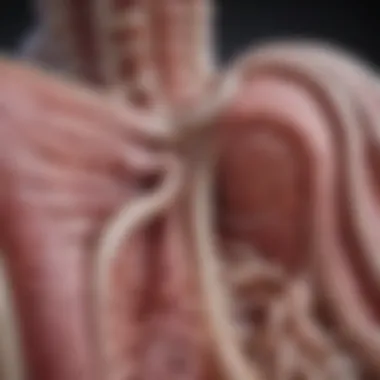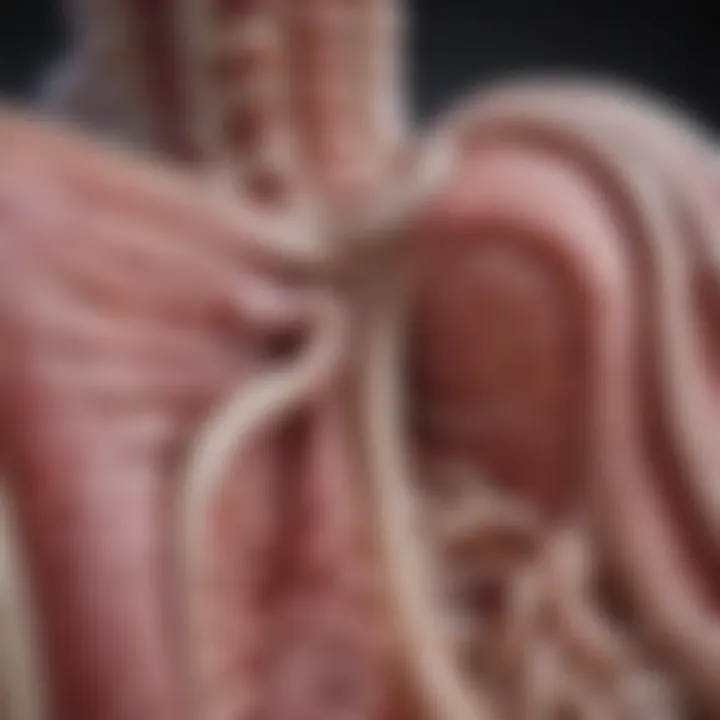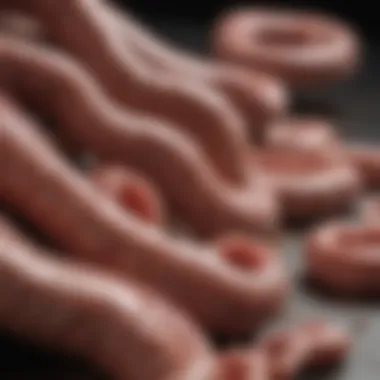Understanding Bowel Obstructions: Key Indicators & Insights


Intro
Bowel obstructions present a significant health risk. They occur when the intestines become blocked, preventing the proper passage of digested food and waste. Understanding the subtle signs is essential for early detection and intervention. In this article, we will examine common indicators of bowel obstructions, their physiological outcomes, diagnostic methods, and potential treatment alternatives.
Recognizing a bowel obstruction involves contextualizing various symptoms. Abdominal pain, for instance, can manifest in distinct ways, including cramping or sharp pangs. Additionally, nausea and vomiting, particularly when they involve bile, can signal a blockage. Changes in bowel movements, such as constipation or diarrhea, further complicate the picture and require thorough evaluation.
Physiological Implications
The human gastrointestinal tract has a remarkable ability to adapt. However, a blockage disrupts its normal function, leading to serious complications. The obstruction can cause the intestines to swell, resulting in inflammation. This scenario may create a more extensive set of issues, including the risk of perforation. Disturbed blood flow can cause tissue death, heightening the urgency for medical intervention.
Diagnostic Pathways
Several methods exist to diagnose bowel obstructions. Physicians typically begin with a thorough patient history and physical examination. During the examination, specific checks can reveal tenderness or abnormal sounds in the abdomen. They often employ imaging studies, such as X-rays, CT scans, or ultrasounds, to visualize the obstruction directly. Each technique provides valuable insights and assists in determining the most effective course of action.
Possible Medical Interventions
Treatment options for bowel obstructions depend on the cause and severity of the obstruction. Non-surgical methods might include fasting and the administration of intravenous fluids. In more pronounced cases, surgical intervention may be necessary. Surgeons may need to remove the obstructing mass or repair any structural issues. Post-operative care and monitoring are also crucial to ensure recovery.
Understanding bowel obstructions is vital for health. By recognizing the indicators early, individuals can seek help promptly, preventing complications that could arise from delayed treatment.
Finale
In summary, bowel obstructions represent a critical health concern requiring awareness of the symptoms and appropriate medical responses. Early detection not only mitigates risks but also enhances intervention outcomes. By fostering knowledge about these indicators, individuals can be proactive in their gastrointestinal health, empowering them to act decisively when necessary.
Prelims to Bowel Obstruction
Understanding bowel obstruction is crucial for recognizing potential health issues that affect the gastrointestinal system. A blockage can cause significant discomfort and has implications for overall health. This section serves to highlight the essential elements and benefits of grasping this condition.
A bowel obstruction may lead to a range of symptoms, from mild, transient discomfort to severe abdominal pain and complications, which can be life-threatening. Therefore, having a thorough understanding of what bowel obstruction entails equips individuals with the intuition needed to identify symptoms early and respond appropriately.
Definition and Types
Bowel obstruction refers to a blockage in the intestines that impedes the normal flow of digested food and waste. This condition can occur in different sections of the gastrointestinal tract, primarily in the small intestine or the large intestine. There are two major types of bowel obstructions: mechanical and functional.
- Mechanical obstruction occurs when there is a physical barrier in the intestines. This can be due to conditions such as adhesions, hernias, or tumors.
- Functional obstruction, also known as ileus, involves a disruption in the normal movement of the intestines without any physical blockage. This can be a result of postoperative complications or certain medical conditions affecting the nerves and muscles of the bowel.
Each type necessitates specific diagnostic and treatment approaches, further emphasizing the need for a nuanced understanding of this medical condition.
Common Causes
The root causes of bowel obstruction vary widely, encompassing various factors. Identifying these causes can assist in prevention and effective management. Some common causes include:
- Adhesions: Scar tissue formed after surgery can lead to blockages in the intestine.
- Hernias: A portion of the intestine may protrude through weak spots in the abdominal wall.
- Intestinal Tumors: Growths within the intestines can obstruct the passage of food and waste.
- Crohn's Disease: This inflammatory bowel disease can cause narrowing of the intestines, leading to blockages.
- Impacted Stool: Severe constipation can result in fecal impaction, causing an obstruction.
Each of these causes calls for a unique diagnostic strategy and tailored treatment plan. Awareness of potential triggers promotes proactive health management.
Recognizing Symptoms of Bowel Blockage
Recognizing symptoms of bowel blockage is crucial for timely intervention. A bowel obstruction can lead to serious health complications if not identified early. Understanding the signs will empower individuals to detect problems before they escalate. This section aims to unravel the intricacies of the symptoms associated with bowel blockage, focusing on how recognizing them can contribute to better gastrointestinal health.


Physical Discomfort and Pain
Pain is often the first and most noticeable symptom of a bowel obstruction. Patients may describe this pain as cramp-like, sudden, or constant. The intensity of discomfort can vary significantly. Some might experience a dull aching sensation, while others may have sharp, excruciating pain. This discomfort typically arises from the inability of the intestines to properly process contents, leading to muscle spasms. If not treated, this discomfort can escalate, resulting in severe complications.
Changes in Bowel Movements
Observing alterations in bowel habits is another key indicator of bowel obstructions. A blockage often results in reduced bowel frequency. This condition may manifest as constipation, where normal stool passage is hindered. Conversely, some patients may experience diarrhea as liquid stool seeps past the obstruction. Both scenarios indicate underlying problems that require attention.
Nausea and Vomiting
Nausea and vomiting are significant symptoms associated with bowel obstructions. They occur as the body tries to expel the contents trapped in the blocked section of the intestine. Often, vomiting may present bile, which is a warning sign. Patients may feel an overwhelming sense of nausea, leading to reluctance in eating. The onset of these symptoms should not be taken lightly, as they can signify that medical attention is needed.
Abdominal Swelling
Abdominal swelling is a physical manifestation of bowel obstruction. When gas and fluids build up in the intestines, individuals may notice a distended abdomen. This swelling may come with a sense of fullness or pressure. Monitoring for this symptom can be vital, especially since it may indicate worsening conditions. If one notices significant swelling, it would be wise to seek medical evaluation promptly.
Key Insight: Recognizing these symptoms early is essential for addressing potential bowel obstructions effectively. Ignoring early signs can lead to emergency situations that could have been avoided.
Understanding these symptoms can enhance one's ability to respond promptly. If any symptoms are observed, it is vital to consult a healthcare provider to discuss potential underlying issues.
Diagnosis of Bowel Obstruction
Diagnosing a bowel obstruction is critical for timely intervention and effective treatment. Accurate diagnosis can alleviate potential complications that may arise from untreated obstructions. The process involves a comprehensive understanding of clinical history, physical examinations, and advanced imaging techniques. By identifying the type and cause of the blockage, healthcare professionals can tailor their approach to management and recovery.
Medical History Evaluation
Medical history evaluation is the first step in diagnosing a bowel obstruction. It helps doctors gather essential information about the patient’s previous health conditions. Specific questions will focus on past surgeries, chronic diseases, and any recent changes in bowel habits. Notably, a history of gastrointestinal disorders can indicate a predisposition to obstructions, leading practitioners to prioritize such factors during assessment. In addition, understanding medication use can offer insights, particularly with opioids, which are known to slow bowel movement.
Physical Examination Techniques
Physical examination involves a systematic approach to assess signs of bowel obstruction. Doctors will start by observing abdominal shape and any visible distension. Auscultation of bowel sounds can reveal decreased activity in obstructed areas. Palpation may identify tenderness or masses, and percussion can help determine fluid levels. Such techniques provide valuable clues, guiding further diagnostic actions. This hands-on evaluation is essential, as it offers immediate insight into the patient’s condition.
Diagnostic Imaging Procedures
X-rays
X-rays are a common diagnostic tool for bowel obstruction. They allow for a quick visual assessment of the abdominal area. The primary advantage of X-rays is their capacity to reveal gas and fluid levels, which are indicative of a blockage. This imaging method is beneficial due to its speed and availability, often being the first test conducted in urgent situations. However, it may not always provide detailed information, and further imaging may still be required for a comprehensive evaluation.
CT scans
CT scans offer a more detailed view of the bowel compared to X-rays. They are particularly useful in identifying the exact location, severity, and cause of the obstruction. One key characteristic of CT scans is their ability to provide cross-sectional images, allowing for a thorough examination of surrounding tissues. This imaging technique is popular because it can detect complications, such as perforations or ischemia. However, the downside includes exposure to radiation and the need for contrast agents, which may not be suitable for all patients.
Ultrasound
Ultrasound is a non-invasive and radiation-free approach that can assist in diagnosing bowel obstruction, especially in children and pregnant women. It uses sound waves to create images of the abdominal organs, providing insight into fluid accumulation and bowel distension. Its key characteristic is the ability to assess blood flow and visualize the surrounding structures in real-time. While ultrasound can be beneficial, it has limitations in detail and may not always visualize deeper structures, potentially leading to missed diagnoses.
Timely and accurate diagnosis of bowel obstruction is crucial for preventing serious complications, including bowel perforation or sepsis.
Treatment Options for Bowel Obstructions
Bowel obstructions can lead to serious health risks and understanding the treatment options is crucial. Timely intervention can prevent complications and promote better recovery. The treatment strategies depend on the cause, severity, and overall health of the patient.


Conservative Management Techniques
Conservative management is often the first line of treatment for bowel obstructions. This approach emphasizes non-invasive measures that can resolve the issue without the need for surgery.
- NPO Status: Patients are usually advised not to eat or drink anything to allow the gastrointestinal tract to rest.
- IV Fluids: Intravenous fluids help keep the patient hydrated and can provide necessary nutrition during this period.
- Monitoring: Nurses and doctors will observe the patient closely for any changes in symptoms or condition. This includes tracking bowel sounds and abdominal distension.
- Laxatives or Stool Softeners: In some mild cases, medication may be used to stimulate bowel movement effectively.
These techniques help in alleviating symptoms and may resolve the obstruction, particularly if it is caused by functional issues rather than structural ones.
Surgical Interventions
When conservative management fails or if the obstruction is due to a serious cause, surgery may be necessary. Surgical interventions vary based on the underlying reason for the blockage.
- Exploratory Laparotomy: This is done to determine the cause of the obstruction and may involve removing tissue or foreign objects.
- Resection: In cases where a segment of the intestine is damaged or diseased, surgeons may remove that part, reconnecting the healthy ends.
- Stent Placement: Sometimes, a stent can be placed within the intestine to open up the obstruction, often used in cases of cancer.
Surgery can provide immediate relief but carries risks, especially in older patients or those with other health conditions. Therefore, the decision must be balanced among the benefits, risks, and the patient’s overall health profile.
Post-Surgery Care
Post-operative care is vital for recovery after bowel obstruction surgery. Patients need careful monitoring and supportive care for decent healing.
- Pain Management: Allowing adequate pain control is important to help the patient move and breathe properly post-surgery.
- Dietary Adjustments: Initially, patients may need to remain on a clear liquid diet, gradually reintroducing solid foods as tolerated.
- Regular Follow-ups: Follow-up appointments are crucial to monitor recovery and detect any possible complications early on.
- Education: Patients should be educated on signs of complications, such as excessive pain, vomiting, or fever, and when to seek immediate care.
Overall, post-surgery care aims to ensure a smooth recovery and minimize the risk of a recurrence or additional complications.
"Timely intervention and proper care can significantly enhance the outcomes for patients facing bowel obstructions."
When to Seek Medical Attention
Recognizing the appropriate time to seek medical attention for bowel obstruction is crucial. Acting promptly can significantly affect the outcome and prevent further complications. The urgency often depends on the symptoms presented and the underlying cause of the obstruction. Identifying critical signs in a timely manner allows for proper medical intervention, which can greatly improve recovery chances. In this section, we will explore vital symptoms that warrant medical evaluation and discuss circumstances that constitute emergencies related to bowel obstructions.
Critical Symptoms to Monitor
Several symptoms indicate a need for immediate medical consultation. Being aware of these can help individuals act swiftly. Critical symptoms include:
- Severe abdominal pain: A sudden increase or a sharp, intense pain may point to an acute condition requiring urgent treatment.
- Continuous vomiting: This can lead to dehydration and may signal a more serious problem in the digestive tract.
- Inability to pass gas or stool: If there is a sudden cessation of bowel movements or inability to pass gas, it signals a potential blockage.
- Rapid heart rate: An elevated heart rate can indicate distress in the body and may be associated with serious underlying issues.
- Fever: A high fever may indicate an infection or inflammation, necessitating immediate care.
It's essential to take these symptoms seriously and not dismiss them as minor discomforts.
Understanding Emergency Situations
In certain cases, bowel obstructions can escalate into emergencies without warning. Understanding these situations can aid prompt decision-making for treatment. Emergency scenarios include:
- Signs of perforation: If there is a tear in the intestinal wall, it is a medical emergency. Symptoms may include severe pain, fever, and high blood pressure.
- Symptoms of septic shock: If an obstruction leads to severe infection, symptoms like confusion, excessive drowsiness, and pale skin may occur. This requires immediate intervention.
- Prolonged inability to eat or drink: If a person cannot consume fluids or food for a long time due to nausea or vomiting, dehydration sets in rapidly, demanding urgent care.
Prompt recognition of these critical symptoms and situations can lead to quicker diagnosis and treatment, which is essential for preventing serious complications.
Preventative Measures
Preventing bowel obstructions is critical for maintaining overall gastrointestinal health. Understanding preventative measures not only aids in avoiding severe complications but also enhances one’s quality of life. Implementing effective strategies involves focusing on dietary considerations and making informed lifestyle modifications. Being proactive is key; ensuring proper measures can lead to significant improvements in digestive health.
Dietary Considerations


Diet plays a crucial role in preventing bowel obstructions. A balanced diet rich in fiber can promote regular bowel movements and reduce the risk of blockages. Here are some dietary tips:
- Increase Fiber Intake: Incorporating whole grains, vegetables, fruits, and legumes can enhance digestive function.
- Stay Hydrated: Drinking adequate water facilitates digestion. Dehydration can lead to hard stools, increasing blockage risk.
- Limit Processed Foods: Processed foods often lack essential nutrients and fiber, which can hinder digestive health.
- Eat Smaller Portions: Consuming smaller, more frequent meals can ease the workload on the digestive system.
These considerations can lead to a healthier gastrointestinal tract, minimizing the chances of obstructions. Regular consultations with a nutritionist may provide additional personalized advice that suits individual health conditions.
Lifestyle Modifications
Lifestyle plays an equally important role in bowel health. Adopting certain habits can significantly decrease the likelihood of bowel obstructions. Here are some effective lifestyle changes:
- Regular Exercise: Engaging in physical activity enhances digestion and promotes regular bowel movements. Activities such as walking, yoga, or swimming can be beneficial.
- Avoiding Stress: High-stress levels can impact digestion negatively. Practicing relaxation techniques, like meditation and deep breathing, may assist in managing stress effectively.
- Quit Smoking: Smoking can lead to a range of digestive issues, so cessation can improve overall gastrointestinal function.
- Monitor Medication Usage: Certain medications can contribute to bowel problems. It is important to review medications with healthcare providers regularly.
These modifications contribute to overall well-being and foster a healthy digestive system. Integrating both dietary and lifestyle adjustments not only prevents bowel obstructions but also promotes better health outcomes in general.
Important Note: Always consult healthcare professionals before making significant dietary or lifestyle changes, especially for individuals with pre-existing health conditions.
The Role of Healthcare Professionals
Healthcare professionals play a vital role in the management of bowel obstructions. Their expertise helps in the early detection, accurate diagnosis, and effective treatment of this condition. A well-coordinated approach involving specialists ensures that patients receive comprehensive care tailored to their individual needs.
Consultation with Specialists
When a bowel obstruction is suspected, it is essential to consult with healthcare specialists. These professionals include gastroenterologists, surgeons, and radiologists, each contributing unique knowledge to the diagnostic process. A gastroenterologist can provide insights into the physiological aspects of bowel function and obstruction. On the other hand, surgeons evaluate the potential need for surgical intervention based on specific patient circumstances. Radiologists are crucial for interpreting diagnostic imaging, helping to pinpoint the location and cause of the blockage.
Benefits of consulting specialists include:
- Precise diagnosis: Specialists utilize advanced imaging techniques, like X-rays and CT scans, to identify the obstruction.
- Tailored treatment plans: After a thorough evaluation, they can design a treatment strategy that may include medical management or surgical options.
- Access to multidisciplinary care: Specialists often work as part of a healthcare team, enhancing the quality of care.
This collaborative approach can significantly influence the patient's outcome and recovery.
Importance of Follow-Up Appointments
After the initial treatment or intervention for bowel obstruction, follow-up appointments are crucial. These appointments serve to monitor recovery and identify any potential complications. Ongoing assessment by healthcare professionals allows for timely adjustments to treatment plans, if necessary.
Considerations for follow-up appointments include:
- Monitoring symptoms: Patients should report any new or persistent symptoms, as they may indicate unresolved issues.
- Assessing dietary changes: Guidance on dietary modifications helps in promoting healthy bowel function post-treatment.
- Preventing recurrence: Regular follow-ups can help address factors that may contribute to future obstructions.
The continuity of care provided through follow-up appointments reinforces the importance of healthcare professionals in managing bowel health effectively.
Effective communication with healthcare providers can lead to better health outcomes and enhanced understanding of bowel obstruction.
Closure
In summary, the topic of bowel obstructions is one of significant importance that deserves careful consideration. This condition affects the gastrointestinal tract, and understanding it can aid in timely recognition and intervention, potentially saving lives.
The role of awareness cannot be overstated. Recognizing symptoms such as discomfort, changes in bowel movements, and abdominal swelling is crucial. It is also vital to understand when to seek medical attention. Early diagnosis often leads to better outcomes.
The article outlines several key elements regarding diagnosis, treatment options, and preventive measures. Understanding these aspects empowers readers to take control of their health. Engaging with healthcare professionals, from specialists to follow-up consultations, highlights the collaborative nature of addressing bowel obstructions.
Additionally, adopting dietary considerations and lifestyle modifications can significantly reduce the risk of occurrences.
By synthesizing this information, readers can grasp the complexity of bowel obstructions and the essential steps for managing this serious condition.
Knowledge is the first step towards effective action against bowel obstructions.
Ultimately, this article aims not only to inform but also to encourage proactive health management. Awareness and understanding are key to navigating the challenges posed by bowel obstructions.



